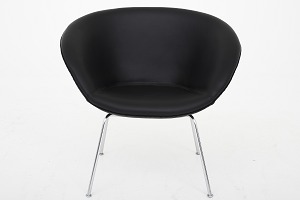Arne Jacobsen 1902-1971
Arne Jacobsen’s international reputation as one of the greatest architects of his time has long been established. He’s famous for an incredible span of designs. Many of the large buildings he furnished were an all-inclusive design, including everything from furniture and textiles to silverware and ashtrays. Arne Jacobsen developed unique furniture models to furnish his own buildings. For example, he designed the Ant chair for the cafeteria of the medical company, Novo, in 1951 and the Egg and the Swan for the SAS Royal Hotel in 1958-60, while his high-backed Oxford chair from 1961 was designed for an English college. In each instance, the assignment was completed as part of an overall architectural solution with a rare concordance between the building and design. Fritz Hansen’s furniture factory enjoyed a close collaberation with Arne Jacobsen from 1952 until his death in 1971. During that period many chairs were devedoped, of of which were revolutionary both technically and design-wise and were all popular for other reasons, as well.
One such design includes the stackable chair, the Ant, where the seat and back are formed in one piece, pressed from a thin, glued piece of veneer, where the simplified sculptural form is reduced to include only the basic necessities; a simplified construction which broke with tradition and formed a natural process in the environment where it was to function.
It quickly became popular as a simple, inexpensive and robust chair, of which more than 5 million are produced today. The Ant was a new creation and became the first industrially produced chair in Denmark. It broke with the national furniture tradition and carpentry, and it also introduced the beginning of mass-production.
In the same manner, he was inspired to design the Egg and the Swan due to the possibilities that the development of styropor plastic introduced. Most of the models are still in production.
Arne Jacobsen’s furniture has enjoyed international popularity and appreciation, and they have contributed greatly to making Danish Design internationally known and considered modern classics.
- Graduated from the Academy of Fine Arts Architect School, 1927
- Employed by the city architect in Copenhagen, 1927-29
- Own architect office, 1929-71
- Professor at Academy of Fine Arts Architect School, 1956-65
- Has designed furniture for master carpenters in Copenhagen Fritz Hansen’s Eftf. A/S, 1952-71
|
- Silver medal at World Exhibition in Paris, 1925
- Academy of Fine Arts little gold medal, 1928
- Eckersberg medal, 1936
- Honor prize at the Biennal in Sao Paolo, 1954
- C.F. Hansen medal, 1955
- Grand Prix International d’Architecture, 1962
- Member of American Institute of Architects, 1962
- Honorable member of The Royal Institute of British Architects, 1963
- Akademie der Künste, Berlin, 1964
- Accadémia Nazionale de San Luca, Rome and Académie Serbe des Schiences, Belgrade, 1965
- Prince Eugen medal and Academic Architects Association’s honor medal and honorable doctorate at Oxford University, 1966
- ID prize, 1967 & 1969
- Honorable doctor of Strathclyde, Glasgow, 1968
- Honor medal from Akademie der Künste in Hamburg, 1969
- Gold medal from d’or, Academie d’Architecture de France, 1971
|
|


